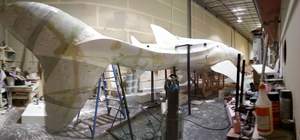DENVER, CO--(Marketwired - Aug 2, 2016) - For sculptor Stephen Kesler, inspiration tends to be grand in scale and magnificent in natural beauty. Kesler, who began his career as a graphic artist at a marketing company, recalls a lifelong fascination with aquatic life and very large animals such as whales, manta rays, and elephants. After 19 years of designing corporate logos and branding materials, websites and print pieces, Kesler discovered the work of Ron Mueck, whose hyper-realistic human figures deliberately break from conventional scale without compromising proportion. Intrigued, Kesler added polymer clay and sculpting tools to the family Christmas list and within a few short years he was creating life-like pieces of his own. Today Kesler's work is prominently displayed in Salt Lake City's Hogle Zoo and the Loveland Living Planet Aquarium in Draper, Utah.
While Kesler's work is mesmerizing, few would guess his primary material. Lightweight, able to be precisely shaped, and large enough to accomplish the life-like scale of mega animals cost effectively -- Kesler uses expanded polystyrene (EPS) foam manufactured by ACH Foam Technologies (ACH). This rigid EPS foam is commonly used to insulate buildings or as a lightweight structural fill for roadway embankments or roof-top plazas.
Kesler begins with a small-scale maquette shaped from modeling clay and then develops a 3D model of the sculpture's internal structure, which is fabricated from steel. The foam is cut to the rough sizes required and attached to the frame using a liquid adhesive. A hot wire cutter is used to remove the initial layer of excess foam, followed by various chainsaws, reciprocal saws, rasps, and continuously smaller tools working into the foam as the animal takes shape. When it's complete the sculpture is covered with one of several special hard-coat applications depending on where the piece will be displayed. Outdoor sculptures are covered in fiberglass for durability. Indoor pieces are covered in a special Class A fire rated compound that passes building code requirements.
While ACH's EPS foam comes in a variety of densities, Kesler works with 1 to 2-pound densities for large pieces because it carves faster. He uses EPS foam in the 2 to 3-pound densities for smaller more detailed sculptures. Kesler returns the foam he shaves off each block to ACH to be recycled and reintroduced into the manufacturing process. His recycling record is eight large trash bags filled with EPS foam shavings created in a single day.
